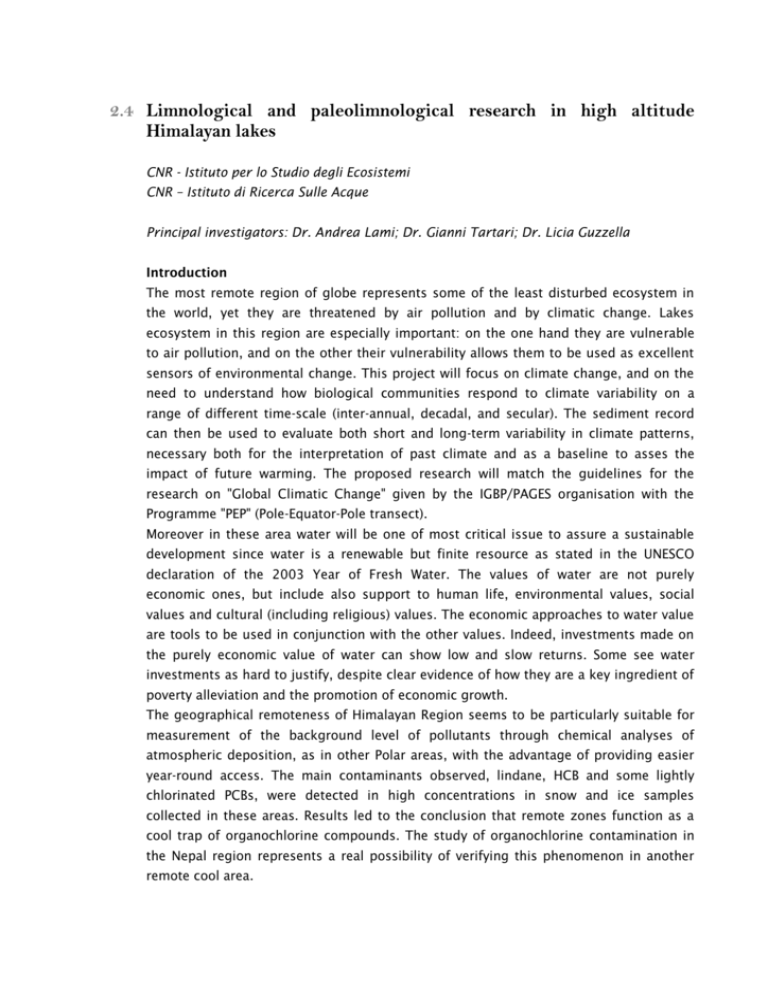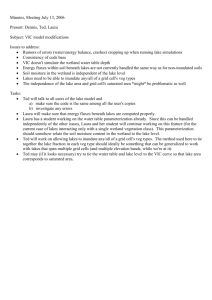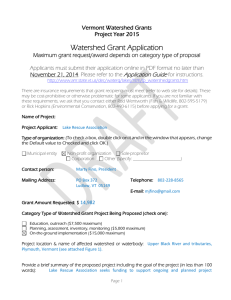PROGRAMMA EV-K2-CNR
advertisement

2.4 Limnological and paleolimnological research in high altitude Himalayan lakes CNR - Istituto per lo Studio degli Ecosistemi CNR – Istituto di Ricerca Sulle Acque Principal investigators: Dr. Andrea Lami; Dr. Gianni Tartari; Dr. Licia Guzzella Introduction The most remote region of globe represents some of the least disturbed ecosystem in the world, yet they are threatened by air pollution and by climatic change. Lakes ecosystem in this region are especially important: on the one hand they are vulnerable to air pollution, and on the other their vulnerability allows them to be used as excellent sensors of environmental change. This project will focus on climate change, and on the need to understand how biological communities respond to climate variability on a range of different time-scale (inter-annual, decadal, and secular). The sediment record can then be used to evaluate both short and long-term variability in climate patterns, necessary both for the interpretation of past climate and as a baseline to asses the impact of future warming. The proposed research will match the guidelines for the research on "Global Climatic Change" given by the IGBP/PAGES organisation with the Programme "PEP" (Pole-Equator-Pole transect). Moreover in these area water will be one of most critical issue to assure a sustainable development since water is a renewable but finite resource as stated in the UNESCO declaration of the 2003 Year of Fresh Water. The values of water are not purely economic ones, but include also support to human life, environmental values, social values and cultural (including religious) values. The economic approaches to water value are tools to be used in conjunction with the other values. Indeed, investments made on the purely economic value of water can show low and slow returns. Some see water investments as hard to justify, despite clear evidence of how they are a key ingredient of poverty alleviation and the promotion of economic growth. The geographical remoteness of Himalayan Region seems to be particularly suitable for measurement of the background level of pollutants through chemical analyses of atmospheric deposition, as in other Polar areas, with the advantage of providing easier year-round access. The main contaminants observed, lindane, HCB and some lightly chlorinated PCBs, were detected in high concentrations in snow and ice samples collected in these areas. Results led to the conclusion that remote zones function as a cool trap of organochlorine compounds. The study of organochlorine contamination in the Nepal region represents a real possibility of verifying this phenomenon in another remote cool area. Main objectives for this research could be summed up as follows: to contribute to the construction of a comprehensive limnological database in order to assess the status of remote mountain lake ecosystems. Data will be collected as required by the EU Water Framework Directive and so will make comparison and exchange of information easier with other ongoing project in mountain area; to provide decision makers with an overall understanding of remote mountain lakes so that appropriate policy and management measures can be taken at both International and national scales to ensure the sustainability of these ecosystems into the future. to define the atmospheric processes of the main organic compounds, like transport and sink, and to reconstruct the sources of these chemicals along with the correlated trace species To achieve these goals we need: 1) To conclude the first complete morphological picture of high altitude lake waterbodies ( 4000 m) located in the Sagarmatha National Park (Eastern Nepal), extending the achieved database and GIS (57% of the surface) to entire territory (1148 km²), 2) To replicate the sampling in some specific environment in order to have information of the short time variability of this communities. The best period for comparing the new results with those from the 1990-98 period is that between mid -September and mid-October. The lake sampling will be conducted in collaboration with other IRSA project regarding measurement of organic micropollutants in lacustrine sediments and with the Institute of Ecosystem Study (ISE) in the framework of consortium named Pyramid LimnoGroup (PLG). Joint expeditions will be planned and coordinated to minimize costs and to reduce the number of researches and instruments involved. Sample and material shipping will be done jointly and a precise repartition of analytical activities will be also planned.; 3) Reconstruct the evolution on a longer time scale with a fine resolution (decadal/secular) of these lakes through a paleolimnological approach. This approach will lead to measure the changes induced by human impact as well as those driven by climatic changes; 4) to conclude the first complete hydroc 4000 m) located in the Sagarmatha National Park (Eastern Nepal), initially developed over the 1990-98 period, within the Ev-K²-CNR Project. We intend to collect a vast quantity of information on high altitude Himalayan lakes never before through this proposed study achieved. The results will be a reference database used also for study of the climatic modification in this area of the Earth; 5) Apply regionalisation methodologies to extend our understanding of individual systems to groups or populations of other systems arrayed spatially across the landscape through a Geographic Information System (GIS) technology; 6) Mountain lake classification will allow comprehensive multivariate analyses to be carried out and the generation for the first time of a very robust ecological classification system for these lakes; 7) determination of background levels of persistent xenobiotics (organochlorine and PAH compounds) at high altitudines, with analysis of lacustrine sediments; 8) evaluation of transport mechanisms in the distribution of organic micropollutants due to metereological factors in remote areas and accumulation in aquatic biotic/abiotic matrices (deposition in bottom sediments or bioconcentration in phyto and zoo-plancton). In order to verify if the contamination is originated by local pollution (i.e. chemical transport from India in monsonic period) or is due to a more large scale phenomenon, as the global change, the sampling campaign will be undertaken by taking in account the local meteoclimatic information and in different exposure period to monsonic winds. For reaching this aim, the research team will collaborate with the Pyramid Meteo Group that will develop an ad hoc chemical transport. Progress report of scientific activity In 2002, thanks to the Comitato Ev-K2-CNR that partially supported this project, was possible to organise a scientific expedition to the Pyramid laboratory-observatory. During this field work activity several lakes located between 4500 and 5500 m a.s.l. were sampled for chemical and biological analysis of lake water and their sediments. In most of the lakes was also installed a mini-thermistor data logger to record the lake water surface temperature year cycle; here we want to better described the period of ice cover duration. A special studies was carried on lakes LCN 09 and LCN 10 (located near he Pyramid laboratory). In these two lakes we have installed a mini-thermistor data logger chain and collected sediment cores of ca. 60 cm in length. All the sampled collected was transported back to Italy for their analysis. Chemical analysis are already completed and results are interesting and consistent with the observed trend in the previous field work expedition pointing to an increase in ionic content of the lake water. The increase in solute content has been interpreted as possible effect of ice cover retreat that expose more soil to erosion and weathering process. Sediment samples have been subsampled and sent to Dr. Licia Guzzella, IRSA, for POP and pesticides determinations. The analysis of organic micropollutants was begun and is still in progress. Scientific activity for 2004 During the 2004 will be concluded the cartographic identification of lake bodies in the Sagarmatha National Park and finished the GIS of Lake Cadastre. In 2004 we will be complete the analysis of the samples collected in 2002. In particular we will do phytoplankton and zooplankton as well as benthic fauna analysis. All the data produced will be uploaded into the limnological database managed by Dr. G. Tartari, IRSA. We will be complete the core analysis especially for pollen and diatom record, but also other biological proxies will be studied (e.g. algal pigment and cladocera). Pollen will give indication of the climatic change in the area as well as could be used as a dating tool to confirm the 14C chronology in LCN 009 (Pyramid Inferior Lake). 14C dating on the sediment core will be performed by external laboratory. In 2004 we will be complete the analysis of the samples collected in 2002. In particular we will do the analysis of organochlorine compounds (PCBs, DDTs. Lindane, HCB, ect…) and of organic carbon content. All the data produced will be uploaded into the limnological database managed by Dr. G. Tartari, IRSA. We will organise a scientific expedition in September/October 2004 to recover the mini-Thermistor data logger and to continue with the sampling activity of the Himalayan Lake Cadastre. During that scientific expedition also the sediment work will be continued. Scientific activity for 2005 In 2005 the analysis of water and sediment samples collected in the previuos fieldwork expedition will be completed. The following variables will be analysed: chemistry, phytoplankton composition, zooplankton, benthic fauna, fossil daitom, fossil cladocera, fossil pigments, organochlorine compounds (PCBs, DDTs. Lindane, HCB, ect…) and organic carbon content. In 2005 the POP analysis will be completed with the determination of PAH compounds (acenaphtene, fluorine, pyrene, fluoranthene, benzo(a)anthracene, benzo(b)fluoranthene, benzo(a)pyrene, indeno(1,2,3,cd)pyrene, coronene, anthantrene ) deriving from fuel combustion. The data will be uploaded into the database and will be used for Publication and presentation of the results.










